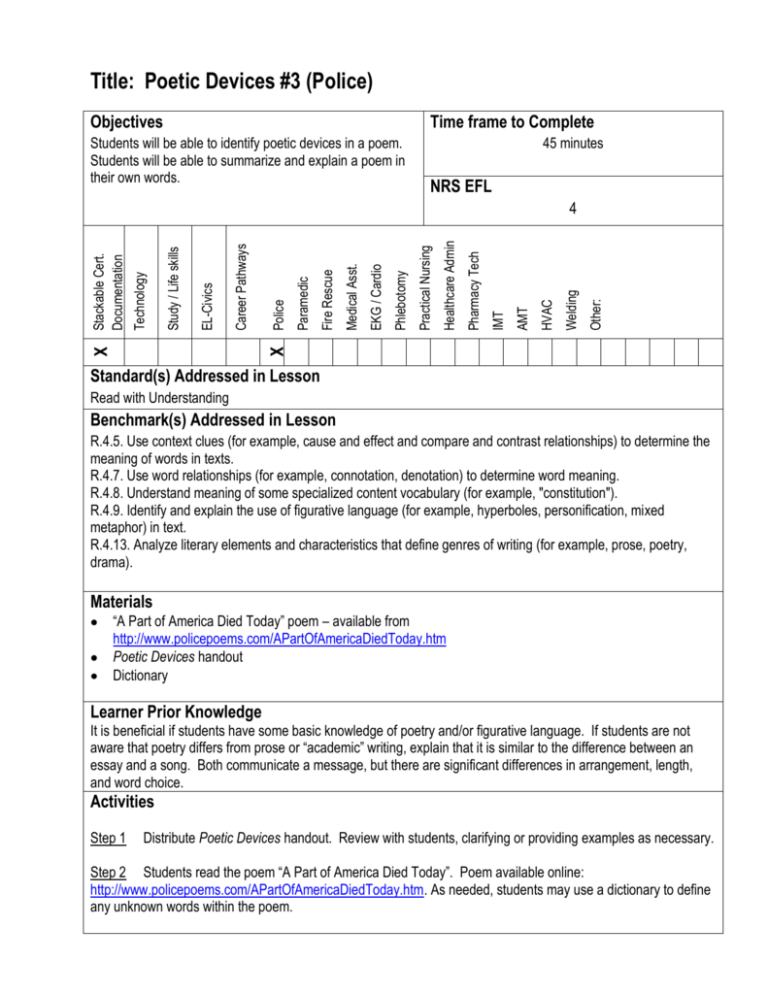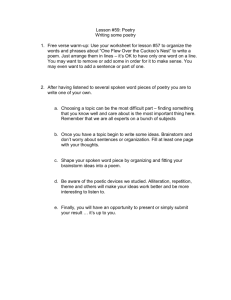Poetic Devices #3 (police)
advertisement

Title: Poetic Devices #3 (Police) Objectives Time frame to Complete Students will be able to identify poetic devices in a poem. Students will be able to summarize and explain a poem in their own words. 45 minutes NRS EFL Other: Welding HVAC AMT IMT Pharmacy Tech Healthcare Admin Practical Nursing Phlebotomy EKG / Cardio Medical Asst. Fire Rescue Paramedic Police X Career Pathways EL-Civics Study / Life skills Technology X Stackable Cert. Documentation 4 Standard(s) Addressed in Lesson Read with Understanding Benchmark(s) Addressed in Lesson R.4.5. Use context clues (for example, cause and effect and compare and contrast relationships) to determine the meaning of words in texts. R.4.7. Use word relationships (for example, connotation, denotation) to determine word meaning. R.4.8. Understand meaning of some specialized content vocabulary (for example, "constitution"). R.4.9. Identify and explain the use of figurative language (for example, hyperboles, personification, mixed metaphor) in text. R.4.13. Analyze literary elements and characteristics that define genres of writing (for example, prose, poetry, drama). Materials “A Part of America Died Today” poem – available from http://www.policepoems.com/APartOfAmericaDiedToday.htm Poetic Devices handout Dictionary Learner Prior Knowledge It is beneficial if students have some basic knowledge of poetry and/or figurative language. If students are not aware that poetry differs from prose or “academic” writing, explain that it is similar to the difference between an essay and a song. Both communicate a message, but there are significant differences in arrangement, length, and word choice. Activities Step 1 Distribute Poetic Devices handout. Review with students, clarifying or providing examples as necessary. Step 2 Students read the poem “A Part of America Died Today”. Poem available online: http://www.policepoems.com/APartOfAmericaDiedToday.htm. As needed, students may use a dictionary to define any unknown words within the poem. Step 3 After reading the poem, students identify four poetic devices in the poem. Students should copy the examples, label each device, and explain the meanings and/or how each device contributes to the meaning of the poem. Step 4 Students share and discuss their examples. Assessment/Evidence Correct identification and explanation of poetic devices within the poem. Class discussion. Adaptations for Beginning Students Beginning students may work with a partner and/or explain fewer (two) examples of poetic devices. Adaptations for Advanced Students Teacher Reflection/Lesson Evaluation This lesson was created by Middletown ABLE. Poetic Devices Poetry is a means of expressing one’s ideas, emotions, or opinions. Often, the only tool an author has for creating his work is words. In poetry, the message is communicated through word choice, arrangement, sound, and rhythm. Poetry is not required to follow the same rules as prose writing, and so standard conventions such as capitalization and punctuation are choices that contribute to the form and meaning of the poem. Poetic devices are ways in which words can be used and arranged to communicate a specific feeling or meaning. Common poetic devices are listed below: o alliteration – intentional repetition of a consonant sound o allusion - a reference to a person, place, or event of which most people are aware o assonance – intentional repetition of a vowel sound o hyperbole - an exaggeration or overstatement o imagery – words, phrases, or details that appeal to the senses o internal rhyme – the use of rhyme within one line of poetry o metaphor - comparison of unlike things without using like or as (e.g. stating one thing is another) o meter - rhythm or pattern of stressed and unstressed syllables o onomatopoeia – a word that imitates a sound o personification - giving human characteristics to the non-living o repetition – the re-use or repeating of words, phrases, lines, or stanzas o rhyme – the similarity of ending sounds in two words o rhyme scheme – the pattern by which lines of poetry are grouped o simile - comparison of unlike things using like or as o stanza – grouping of two or more lines of poetry by length, rhythm, rhyme, and/or idea (also called a verse) o symbol – an object or action that represents something other than its literal meaning Read the selected poem two times. 1. In the first reading, concentrate on understanding the poem. a. Look up unfamiliar vocabulary words. b. Think about what message the poet is communicating. What idea or feeling are you left with after reading the poem? 2. As you reread the poem, look for four examples of poetic devices. For each example, write the following: a. Type of poetic device b. Copy the line (or lines) in which it occurs. c. What does it mean OR what effect does it have on the poem? Example #1 Example #2 Example #3 Example #4







